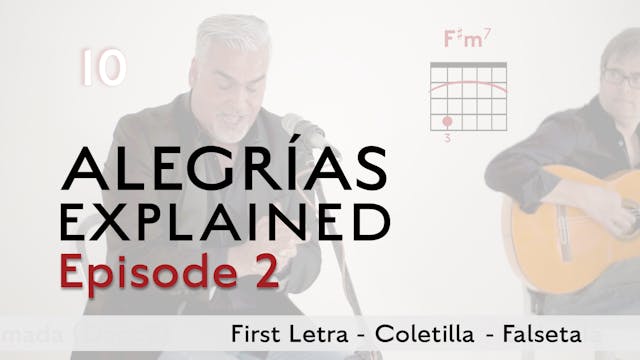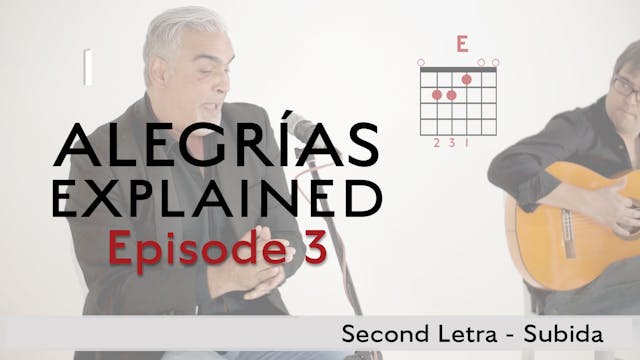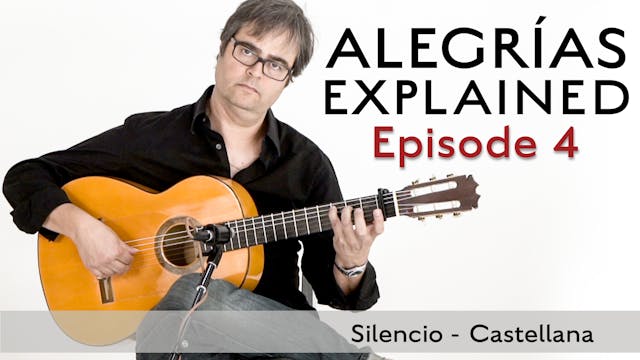The first lesson looks at starting an Alegrias. As a guitarist, the only part of this where you need to play what I play is during the Cante, and then only if the singer is singing traditional letras. The falseta can be anything at all. You can even start Libre, or you can start with compás if you prefer or if you don’t have a falseta ready. (You can find the lesson and notation/TABS for a version of the falseta I play here - https://learn.flamencoexplained.com/alegrias-falsetas-playlist/videos/alegrias-minerachords-tut and you can learn a few more falsetas here in the Alegrias Falseta playlist - https://learn.flamencoexplained.com/alegrias-falsetas-playlist. )
During the sections of the dance that don’t have Cante you can play whatever chords you want, really, as long as you’re in Compas! You can stick to variations of B7 and E, as I mostly do, you can just play those two chords and nothing else, or you can play more varied chord progressions. But if you play a progression be ready to resolve at any moment - an experienced dancer will hear your chord progression and wait for you to resolve before closing or calling, but a less experienced dancer may be dancing to a set choreography and therefore unable to wait for you!
All of the Llamadas I play are improvised, and in a few sections I mimic what Manuel is playing. You don’t have to use the same right hand patterns I use or do anything exactly as I do, really. The main thing at first is to stay in compás and follow the tempo of the dancer (palmas help a lot here!). For your Llamadas just think about changing from E to B7 on beat 3 and resolving back to E on beat 10. You’ll want to accent 3, 6, 8 and 10 a bit harder than usual to say ‘Llamada’. Alternatively you can hit 3, 7, 8, 10. The 3 and the 10 are really the most important accents in your Llamadas, but the 6 and 8, or 7 and 8, should also be accented.
Here are a few resources and review materials for you to look at as you learn to accompany Alegrias:
Glossary Terms:
Tapado/Palo Seco (glossary) - https://learn.flamencoexplained.com/flamenco-video-glossary-pocket-guide-free-1/videos/llamada
Llamada (glossary) - https://learn.flamencoexplained.com/flamenco-video-glossary-pocket-guide-free-1/videos/a-palo-seco
Alegrias compás - https://learn.flamencoexplained.com/alegrias-playlist/videos/alegrias-compas
More Alegrias compás - https://learn.flamencoexplained.com/alegrias-playlist/videos/7-8-9-phrasees
Accompanying the Cante in Alegrias - https://learn.flamencoexplained.com/videos/cante-alegrias
Palmas:
Alegrias Palmas - https://learn.flamencoexplained.com/palmas-playlist/videos/palmas-overview
Solea - https://learn.flamencoexplained.com/palmas-playlist/videos/palmas-solea
Our Alegrías playlist on Tidal: https://tinyurl.com/alegriasplaylistontidal
Up Next in Alegrias Explained
-
Alegrias Explained - Episode 2
In the second lesson we look at the first letra and the Coletilla and how to accompany them. These two sections of the cante generally follow the exact same chord progression, but they feel different. From there we get into the falseta and then the Llamada for the second letra.
It’s traditional...
-
Alegrias Explained - Episode 3
In this week’s episode we look at the second letra of the danced Alegrias - how to get into it, the letra itself, and what happens after. The accompaniment of the cante is the same as in the first letra - you can review that here: https://learn.flamencoexplained.com/videos/cante-alegrias - but ge...
-
Alegrias Explained - Episode 4
In this week’s episode we look at the Silencio and the transition into the Castellana. The Silencio itself is pretty standardized - it’s essentially a mini guitar solo that is slow, lyrical and in the minor key, and it’s one of those things you can actually have prepared beforehand. The Castellan...




9 Comments